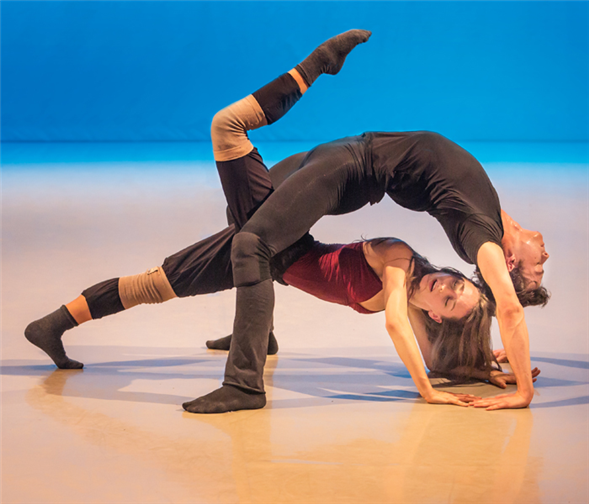Translate Page

Inside the company's latest New York program
The Martha Graham Dance Company's repertory for its two-week season at the Joyce Theater covers a remarkable number of bases.
With an eye toward legacy, the program includes five examples of Graham's own modern dance choreography. Selections range from Primitive Mysteries, a stark, ritualistic 1931 masterwork, to Maple Leaf Rag, a high-spirited romp created nearly 60 years later.
At the same time, the company is venturing well beyond its venerated founder, commissioning dances from a range of international choreographers. This season, which runs February 14-26, features premieres from Annie-B Parson and Sidi Larbi Cherkaoui.
For Janet Eilber, a former Graham principal dancer who is now the company's artistic director, choosing choreographers for the company is partly about "balancing the Graham repertory. We want someone who really has fulfilled their own voice and can bring something different."
She also selects a unifying theme for each season's repertory, influenced by which of Graham's many works are being revived. Because she felt it was time for both Primitive Mysteries and the 1947 Dark Meadow to return, Eilber chose "Sacred/Profane" as this year's thematic focus. In addition, she says, "we had been looking for a way to connect to the Middle East. We knew we weren't going to do anything obviously political, but we wanted to focus on the spiritual connections – the things that art connects to. That really speaks to the Sidi Larbi piece."
Cherkaoui, whose most recent work to be seen in New York was the full-evening Babel at Lincoln Center's White Light Festival, was right on Eilber's wavelength. Raised in Antwerp by a Moroccan father and Belgian mother, he had a lifelong yet ambivalent connection to Islamic culture. "I grew up in Belgium with the culture of Islam, though I'm not Muslim at all now," he says. "We went to Morocco for holidays. My father always played Arabic music, and we had a lot of Arabic aesthetics in the home. Arabic letters all flow into one another. In many ways, my choreography was influenced by the way I see the world: everything flows. I try to communicate and share that."
His European dance training brought him into contact with Graham's work. "The first modern classes I took in Belgium were Graham technique," he recalls. "It was one of the first styles that gave me a relationship with the floor – being allowed to dance on your knees, on your sit-bones. Graham was part of a foundation for me, a big influence."
Mosaic, the work he has choreographed for nine Graham dancers, is set to a soundscore by Felix Buxton that incorporates Lebanese, Sephardic, and Syrian music, among other styles.
"I was interested in the concept of mosaic because it's all these little stones that you put next to each other, and all of a sudden they come together and create a bigger shape," Cherkaoui says. "So for me there was something about connecting the abstract with the reality of today – especially everything that's happening politically. It's very important to remember how diversity creates identity."
Eilber presented Annie-B Parson with a specific challenge. A film existed of Graham's 1941 Punch and the Judy, a nearly forgotten satirical work created amid many of her most enduring – and serious – dances. "It was fabulous material, but I felt that an authentic reconstruction was not right for today's audiences," Eilber says. "I sent Annie the film, and she jumped on the chance to work on it in her own inventive, unique way."
As co-director (with Paul Lazar) of Big Dance Theater, Parson specializes in transforming and translating works of literature, film, and theatre into something boldly new. In this case, Graham's work drew on Punch and Judy marionette shows – a British tradition – with the focus on a married couple's travails.
"For me, it was like catnip," Parson says. "Of course I wanted to do something with it, because I love archival material. It's hard to understand Graham's sensibility in that moment. I think she was finding a different tone to express what I thought was coming from a real place of pain."
Parson was given complete freedom to find her own take on Graham's original. The result is I used to love you, which includes text by Will Eno and a score by Tei Blow. Describing her approach, she says, "It's like I'm picking at the bones of the original choreography. It's there, but it's so manipulated and run through so many processes. I would resurrect aspects of it that I really respected and could relate to. The thing that I maintained was the sequence of events, and the really skeletal aspects of the dramatic arc."
These pieces wouldn't work, of course, without the Graham dancers, and Cherkaoui says they are eager collaborators: "There was an extreme openness to connect the dots, and to really see how what I'm proposing is a branch out of the tree of what they're used to feeding from. It's still connected."
---
TDF Members: At press time, discount tickets were available for the Martha Graham Dance Company season at the Joyce. Go here to browse our current offers.
Susan Reiter frequently covers dance for TDF Stages.
Photos by Brigid Pierce. Top photo: A rehearsal for Cherkaoui's 'Mosaic.'